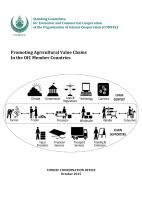

Promoting Agricultural Value Chains
In the OIC Member Countries
29
selected: Agriculture & Food, Horticultural & Propagating Stock, Chemicals, Creative Industry,
Energy, Life Sciences & Health, Logistics, and Water.
The top sector policy is based on a combination of generic financial instruments and a
pronounced emphasis on cooperation in the ‘golden triangle’ formed by companies, research
institutions and government to implement a sector-based and integrated approach. When the
policy was released, each top sector was asked to establish a ‘top team’ of representatives from
industry, knowledge infrastructure and government to develop draft knowledge and
innovation agendas for consideration by the government. The government evaluated these
agendas based on the level of ambition, commitment of stakeholders, openness, balance
between social and economic objectives, and the extent to which objectives can be measured
(OECD, 2014). The agendas and relationships were subsequently formalised as ‘top consortia
for knowledge and innovation’ (TKIs) which develop strategic action plans, coordinate
research activities, and build linkages to education, the labour market and economic diplomacy
(AWTI, 2014). The government’s aim is to leverage more than 500 million euros of public and
private funding, and at least 40 percent by the private sector by 2015.
Agriculture plays a key role in the Top Sector policy, as it is one of the driving forces behind the
Dutch economy and accounts for about 10 percent each of national GDP and employment
(Hollandtrade, 2013). The Netherlands is the world’s second largest exporter of agricultural
products and one of the leading producers of fruit and vegetables. At the same time, the sector
faces challenges, such as pressure on the environment and a structural shift towards large-
scale and more intensive farming, which require an adaptive institutional framework.
The two top sectors relevant for agriculture, Agro & Food and Horticulture & Planting
Materials, focus on creating an enabling environment to strengthen the international position
of the Dutch agriculture by promoting innovation and competitiveness. The ambition of Agro &
Food is to make the Netherlands the world leader in this area by building on the country’s
strong export position to meet the challenges of producing more food with less inputs,
developing new products with greater added value, and addressing international food
problems through innovations in sustainable production. The ambition of the Horticulture &
Planting Materials is to double the growth in added value through new product innovations
and become a world leader in sustainable solutions by 2020 (Berkhout et al., 2011). Since
accessing and tapping into new export markets is a key priority, Dutch cooperation with China
has been identified to be of strategic importance to support the expansion and diversification
of Dutch agricultural exports into China (The Hague Centre for Strategic Studies & LEI, 2014).
The Top Sector policy also serves to ensure that the Dutch agricultural sector is able to cope
with and make use of changes expected to occur in the future. Such changes include the
anticipated declining importance of livestock production and the growth opportunities for
value added and employment in arable farming, greenhouse horticulture and open-field
cultivation (Berkhout et al., 2011). Processing and logistical links are also expected to grow
whereas the importance of primary and supplying links are estimated to decline (Berkhout et
al., 2011).
As a result of the Top Sector policy, the government’s role in industrial policy has changed
from management-by-subsidy to network management (AWTI, 2014). The Government does
not make its own proposals to promote the sectors, but depends on the TKIs to develop
concrete lines of action (OECD, 2014). This has the advantage of facilitating demand-driven
rather than government-centred policies and reducing regulatory and administrative burden
on businesses (OECD, 2014). Although it is still too early to make conclusions about the effects
of the Top Sector policy, in their 2014 status update, the Advisory Council for Science,

















